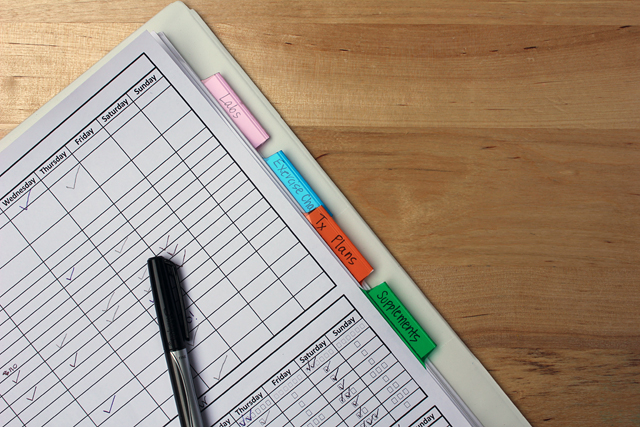Make Your Own Health Management Notebook
bless your body by documenting your health journey

When I was first diagnosed with interstitial cystitis back in 2003, it felt like my life was crumbling. I was notably depressed but too disconnected from my emotions to admit it. If my body jolted the wrong way, it triggered megadeath bladder spasms that felt like my bladder was contracting on razor blades. I had little interest in taking care of myself, let alone my yellow parakeet named Babu (who was probably smuggled illegally from South America).
Because I went to the doctor like it was my job, I got a lot of doctor papers. Those papers never made it into one centralized location. I was too busy, too exhausted, too sick, and too angry to care. At the bottom of all that, there was no desire to care because I hated myself. There was no point in managing my health papers if I didn’t care about my health.
Making my own health management notebook was part of my recovery process. It is a tool I still use every day to bless my body and not hate on it. It has enabled me to lovingly sow health into my life. I relish in the care I feel for myself when I look at it. It reminds me that my health has value.
Creating a health management notebook is easy and inexpensive! All you need is a 3 ring binder, something to segregate the binder into sections, and tabs for labeling each section. Make it in a way that encourages you to cultivate health in your life. If that means using Martha Stewart’s cute office supply line, than do it for the sake of your (precious) health!
Here’s what you should stick in it:
1. Active Medication & Supplement List with current dosages
You would be surprised at the number of people unintentionally taking the WRONG dose of prescribed medication. By having it listed in one centralized location, it’s a double safety check. It’s also helpful to bring this up-to-date list with you every time you see your doctor. By staying on top of it, it’s always ready to go.
2. Health Habit Charts
I make my own weekly health habit check-off chart, which you can partially see in the photo above. Making a health habit check-off chart has taken my health to a new level. I make one for each week, and once it’s filled, I stick it in my health management notebook so that I can look at my progress over the past month. It keeps me accountable to my health goals. I’m also able to notice when I haven’t been to the gym in 4 weeks. You can make different health charts according to themes, like a simple exercise chart that tracks your workouts. I know there are apps for these kinds of things, but I thrive on the psychological high I get when I give myself a check with a sparkly green glitter pen.
3. Treatment Plans & Handouts
Naturopathic doctors are notorious for giving you a paper treatment plan every time you visit the office. Instead of having your treatment plans scattered all over the house and the recycling bin, why not organize them in one spot? It’s rewarding to look back at past treatment plans to see how far you have come. By placing your treatment plan in your health management notebook, it helps you focus on what your doctor recommended. You should also be sticking in any other paper handouts your doctor gives you, unless they are already found online.
4. Laboratory Blood Work & Other Labs
All the labs you have ever had done should be centralized in one location in your health management notebook. Organize your lab work by date, so you can see what’s been going on over time. From now on, always request a copy of your labs and stick them in your health management notebook. Because your labs provide scientific data, they are a tangible way to see if all that exercise and expensive fish oil was worth it. You can see your own numbers change over time. Besides, no one cares more about your health than you do, and clinics want to get rid of your records as soon as the law allows them. These documents are also something your children would love to see when they grow up, especially to identify familial health patterns. Hold on to them!
5. Imaging Reports
Although you are not trained to read an x-ray or MRI, you can still obtain a copy of the doctor’s report. This is basically his interpretation of the findings. Imaging reports are the most crucial thing to keep in your health management notebook, simply because you don’t want to have to re-do things later due to carelessness of lost files. Most imaging exposes you to harmful radiation. An MRI of your neck from 2001 could show slipped cervical discs, and could potentially explain all the tingling in your hands in 2012. It’s always helpful to look back over these reports, and to give a copy of them to new doctors when you see them.
Enjoy More Archerfriendliness
Our greatest source of pesticide exposure comes from food.1 Pesticides are either water or fat soluble. Water soluble pesticides easily leave your body through the kidneys. Fat soluble pesticides l...
If you are addicted to using the fluorescent pink tummy coolant to manage your belly pain, this herb is for you. Using marshmallow root in place of Peptol-bismol will do more for you than simp...
Since it is World Breastfeeding Week, I would like to intercept my detox series with some talk about breastfeeding. There is a worldwide initiative backed by the World Health Organization (WH...








Erika
October 22nd, 2012 at 8:24 am
Archer, what a great idea! I was thinking about supplying my patients with a health binder at their first visit, but now I think I may include tabbed dividers too. It is so hard to keep track of treatment plans, this will make everything easier.
Reply
Dr. Archer
October 22nd, 2012 at 10:04 pm
Thanks, Erika! I hope to offer some kind of health management binder to my patients as well. If you have any more ideas on the tabs, let me know!
Reply